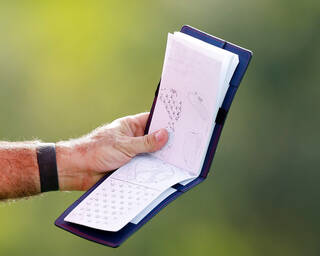AimPoint Putting: Learn the Polarizing Green-Reading Method

Try explaining to a non-golfer that there’s a method of reading greens that’s highly controversial and wildly polarizing. It sounds silly to say out loud, but Aimpoint Putting gets people riled up, whether they’re defending or criticizing the putting technique.
If you’ve spent any time watching golf on TV or checking in with golf social media, you’ve seen the AimPoint putting technique. It’s the one where golfers waddle along the green, feet straddling their line, then holding up a couple fingers and squinting. Yet somehow Adam Scott still makes it look cool.
In fact, many elite professional and amateur golfers rely on AimPoint. Even Dustin Johnson used AimPoint to successfully navigate the tricky greens at Augusta National to win the 2020 Masters.
So what exactly is AimPoint putting, and is it for everyone, or just the pros? We’ll break down AimPoint putting, including the AimPoint Express putting method, and how you can try it out in your own game.
AimPoint Express Putting in 3 Steps
AimPoint putting is a green-reading method designed to give golfers a quick (that’s debatable) and accurate read and a specific target for each putt.
The original AimPoint putting technique incorporated a highly detailed chart that contained 600 numbers in a bullseye-looking diagram. Golfers needed to pinpoint three numbers from this chart that related to their putt. This became problematic when players uses the system before they were fully familiar with the chart, causing slow play issues.
Thus, AimPoint Express was born. Here’s how to use it.
Step 1: Use Your Feet to Determine the Slope
The fundamental skill required is the ability to correctly determine the amount of slope, in degrees, of each putt. A typical putt has about one to two degrees of side-slope, and therefore break. A steep putt could have as much as five or even six degrees.
Use your feet to gauge the slope of your putt at your ball, and from roughly halfway between your ball and the hole on longer putts. After determining the slope from both points, take the larger of the two slopes for step 2.
The crux of AimPoint is having the ability to gauge slope with your feet. There are four good ways to learn how to do this, and we’ll go over those shortly.

Golfer's perspective using AimPoint on a putt with 1 degree of slope
Step 2: Find Your AimPoint
Once you’ve mastered reading slope with your feet, AimPoint is easy.
To find your AimPoint, hold up the number of fingers that corresponds to the degrees of slope your putt has, as identified in Step 1. Center your pointer on the cup with your additional fingers on the high side of the putt. The edge of your outside finger is your AimPoint.
For those of you asking, yes, using AimPoint is completely legal.
Step 3: Hit Your Putt
Now that you know the perfect starting line of your putt, align your ball to that point, and hit your putt to that target. If you’ve judged the slope correctly, and give it the right speed, you’ll watch your putt drop to the bottom of the cup.
4 Ways You Can Learn to Read Greens With Your Feet
By now you’ve surely noticed that using AimPoint hinges on a skill you don’t currently have. That is, your ability to use your feet to differentiate a putt with 1 degree of slope from one with 2, 3 or 4 degrees of slope. That’s not a skill we’re just born with, but there are four ways you can learn it.
Before we go into how to learn AimPoint, and reading greens with your feet, now is a good time to mention that AimPoint is actually patented by inventor Mark Sweeney. Only certified instructors can teach the official method and much of the information is proprietary.
You can check out the AimPoint Putting patent, which includes four AimPoint Putting charts. If you’re good at decoding technical patent language, it could give you more insight into using AimPoint than we can give you here. The patent is set to expire in February of 2029.
1. Attend an AimPoint Clinic
AimPoint offers in-person clinics with certified instructors for around $200-250. Clinics are run in the United States and globally. Clinics are often limited to 6-8 golfers and run between 90 minutes and 3 hours.
Check out the upcoming AimPoint Clinics.
2. AimPoint Video Lesson
If you don’t have the time and money – or you’re just not willing to invest them into your ability to read greens – you can get official AimPoint instruction via the 33-minute video course.
For $50, you can get the DVD or streaming access to the instruction.
3. Use a Digital Level
In lieu of formal training, you can invest in a digital level to bring to your practice putting green. Spend a few hours calibrating your body to correctly gauge slope. If you practice diligently and test yourself compared to the digital level, you can learn how to determine a putt’s slope with your feet.
4. Use a Green-Reading App or Book
If you’re more the instant gratification type, a green-reading book or app can get the job done as well. In fact, the USGA’s GHIN app, which many golfers use to input their scores after each round, now offers green-reading diagrams with a “heat map” showing how steep and in which direction putts break.
If you play most of your rounds at one course, it could be worth purchasing a green-reading book for that course, which indicates the slope severity of essentially every putt on green on the course.
Whether you prefer digital green-reading maps on your smartphone, or a hard copy in your pocket, detailed green maps, with slope, are very accessible these days.

Using Golf Yardage Books to Play Like the Pros
What About Speed?
Knowing the slope of a putt is one thing, but determining the exact break and path the ball will take into the hole is impossible without factoring in speed.
A putt can take various lines into the hole depending on its speed. A firmly-hit putt can drop on a much straighter line than one that dies in the hole and utilizes more break. The AimPoint putting method advises an ideal speed of one foot past the hole.
Who Uses Aimpoint Putting?
AimPoint boasts that its methodology has been used by 75,000 amateur golfers, 5,000 juniors, 200 tour professionals, and 300 instructors, including five World No. 1 players. Here’s a list of just some of the well-known golfers who have used AimPoint:
- Dustin Johnson
- Adam Scott
- Max Homa
- Lydia Ko
- Keegan Bradley
- Ian Poulter
- Hunter Mahan
- Justin Thomas
- Akshay Bhatia
- Jordan Spieth
- Brooks Koepka
- Justin Rose
The Great AimPoint Debate
While there are plenty of merits and all the validation needed to prove AimPoint at least can help golfers putt more effectively, there’s a large group of golfers and fans who think the method should be abolished.
Those critics say that the process not only slows down play, but causes unnecessary stress on greens as players trample through putting lines, shifting their weight from one foot to the other.
Adding even more fuel to the fire are players who employ the AimPoint method on very short, straightforward putts, and don’t even get them started when those putts still don’t drop.
Of course, the easy counter-argument is that players are going to take some time to read putts, regardless of the method. And, if AimPoint helps them make more putts, it will speed up the pace of play, rather than slow it down, in the long run.
Regardless of what side of the debate you’re on, barring intervention from golf’s governing bodies, AimPoint is here to stay.